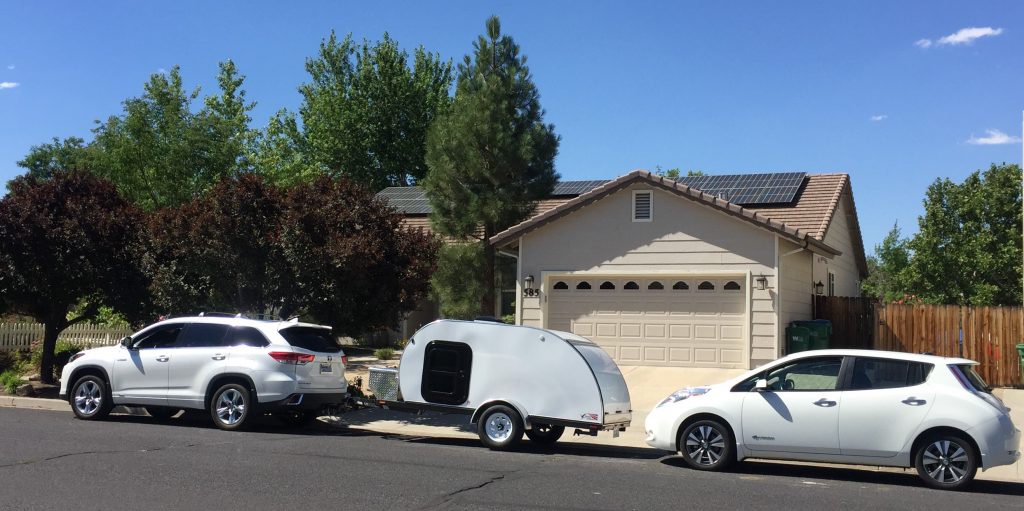
Our solar panels on the roof
Our Online SolarEdge Panel. Click to see what we are producing with our rooftop solar array!
Reflections on our Second Year of Going Solar & Driving the Cars of the Future
I won’t repeat here all I said in my first annual report, so if you want to read that one, click this link: https://rhondaashurst.com/2020/02/03/1st-annual-solar-report-for-2019/. This post gives information on our initial set up and the purchase of our EV and Hybrid vehicles.
IT JUST KEEPS GETTING BETTER! We continue to enjoy the thrill of driving the cars of the future, greatly decreasing our carbon footprint, using the sun to power more of our home and transportation, and watching the savings pile up. Of all our home improvements, going solar has been our best decision.
Our gratitude to Travis and the guys at Great Basin Solar (https://www.greatbasinsolar.com/) for the awesome job they did designing and installing our system!
Here’s the summary for this year with cumulative data:
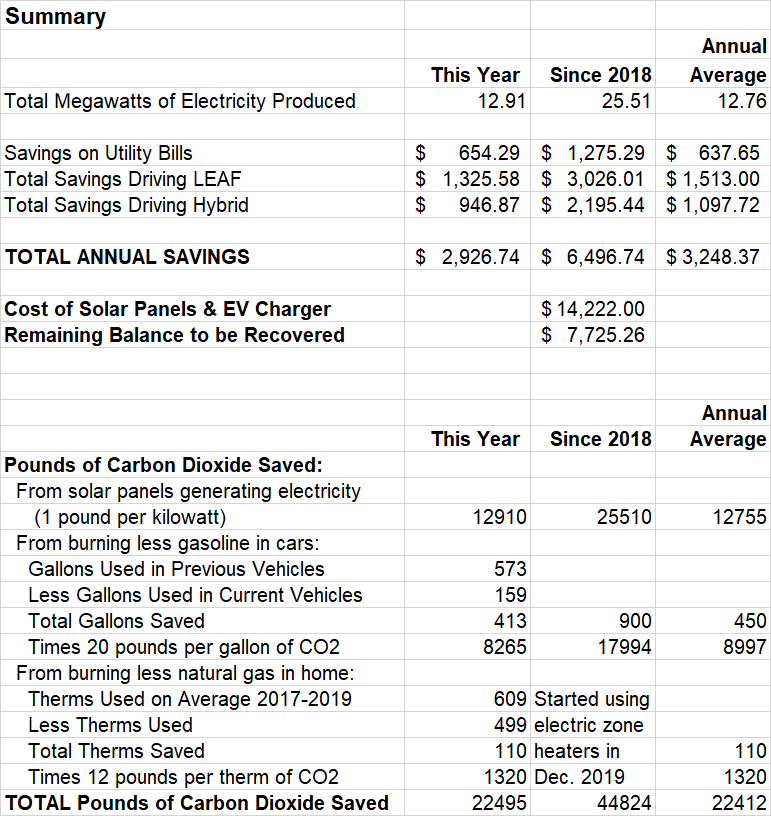
We produced about 13 megawatts of electricity in 2020, about 1 megawatt more than originally estimated. We saved almost $3,000 between our utility bills and the lower costs of driving electric and hybrid vehicles. At this rate, we will recover our costs in 2.5 more years. We also saved over 22,000 pounds of CO2 from entering our atmosphere, and a total of nearly 45,000 pounds over the 2 years since we installed the system!
This year I added in our CO2 savings from burning less natural gas in our home, due to using electric zone heaters during the winter. Next year we plan to replace our aging water heater and air conditioning unit with super-efficient electric heat pump models. The A/C unit will include a heater that extracts heat from the air to warm our home in the cooler months, reducing even further our use of the gas furnace. It will be fun to see how much more gas we will save in the coming years by making those two simple changes that we need to make anyway.
It is definitely driving the cars of the future that saves the most. For a fun read on what you can save by driving electric or hybrid vs. gas-powered vehicles, check this out: Article on cost and climate savings of Electric and Hybrid Vehicles. It includes information from MIT on a variety of different cars–the cost of driving them and their carbon emissions.
THE DATA
Electricity Production and Accumulated Credits
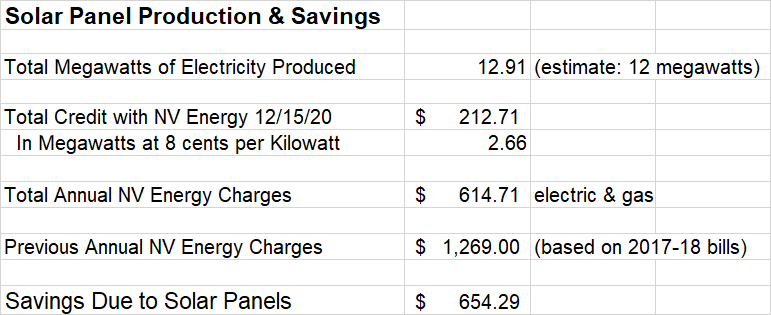
Our panels produced 12.9 megawatts, almost 1 megawatt over what Travis estimated when he built our system. We only slightly increased our banked electricity with NV Energy to 2.66 megawatts from 2.60, so we used almost all the electricity we generated this year. The difference was caused by (1) using electric zone heaters in the winter to reduce our gas usage, (2) plugging in a second refrigerator for most of the year due to stocking up to weather the pandemic and keep our parents supplied with groceries, and (3) running more A/C at night in the summer.
Averaging our 2017 and 2018 utility bills, we paid $1269 annually for electricity and gas. This year we paid only $614 for a savings of $654! We decided to look at our total utility bill, since we are now using electric heaters to lower our use of natural gas to heat our home in the winter. Next year we expect to use even less gas when we install the new heat pump systems.
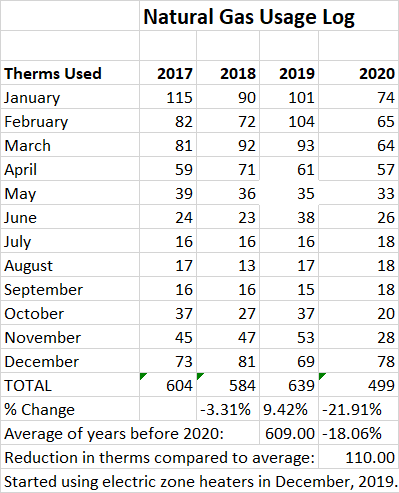
The Natural Gas Log is a record of our gas usage in therms. It went down 18% in 2020 for a savings of 110 therms and 1320 pounds of CO2. We are excited to see how much it will change when the new systems are installed!
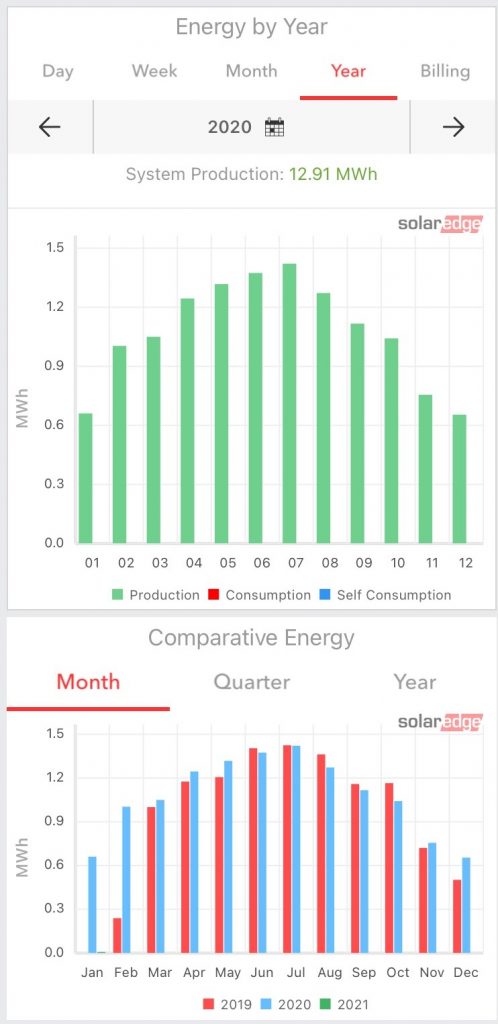
Above are the SolarEdge graphs showing our total production in 2020 and the comparison of 2019 and 2020. Our system didn’t go online until February 19, 2019. You can see that our lowest production months are November-January, which is when we are using the electric zone heaters and running Christmas lights. It’s during these months that we tap into our banked power with NV Energy. In the higher production months, we send more power into the grid, which is used by other households and increases our banked power.


This is our December NV Energy bill showing our banked credit of $212.71 (line right above Meter Information). Divided by the 8 cents per kWh charge, the bank equals 2.66 megawatts of stored power. We used less electricity this December than last December, because we switched from incandescent to LED Christmas lights for the exterior of our house. We couldn’t believe it when we learned that 1 incandescent bulb uses the equivalent of 2 STRINGS of LED lights! OUCH! So, we ought to use a lot less electricity for the 6 weeks of Christmas lights.
The changes we made this year saved natural gas and used more of our solar power. Once the new systems are installed in 2021, we may start tapping into our bank. We’ve decided to monitor our electric use for a year and if we need to, we will install more solar panels.
2016 Nissan LEAF
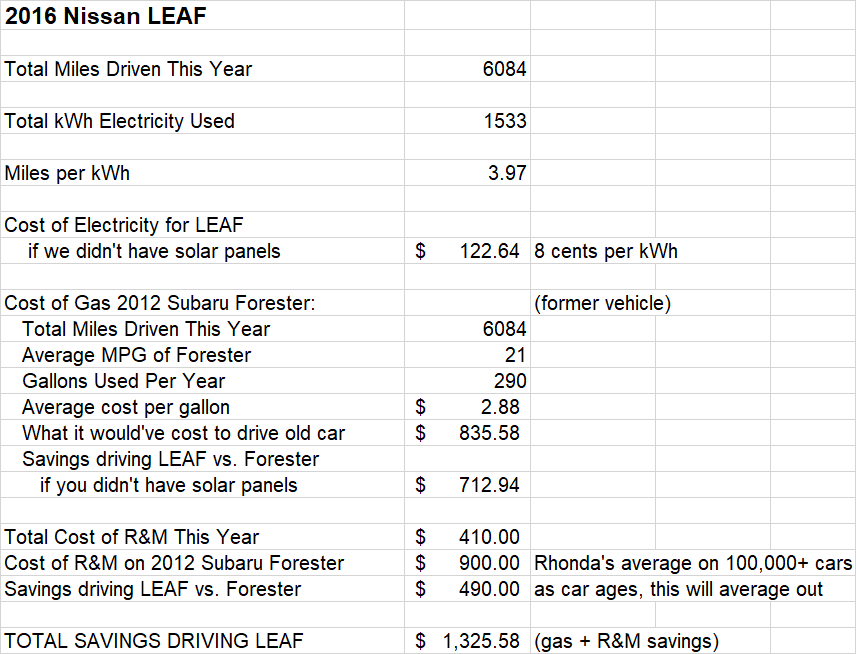
We are still loving driving our LEAF! We used BeeBee even more than the Highlander this year, since we didn’t travel long distances as much due to the pandemic. However, the total miles driven (6084) was about the same as last year. We used 1.5 megawatts of electricity to power her. If we didn’t have solar panels, it would’ve only cost us $123! That is a savings of around $713 over my old Subaru! (So, it pays to have an EV whether you have solar or not.) But, because we have solar panels, our savings is actually $836! Plus we saved 5800 pounds of carbon dioxide from entering the atmosphere (290 gallons X 20 lbs/gallon of gas).
We also saved money on repairs and maintenance. I have driven 100,000+ ICE vehicles for most of my life and they have high R&M bills, about $900 per year on average. This year the LEAF had her 30,000 mile check up, which is a big one, but it only cost $410. So the LEAF cost $490 less to maintain than my old vehicles. This brings the total savings of driving the LEAF for a year to $1,323! (NOTE: This will decrease as the car ages and the R&M bills get higher.) In future years, I will keep a running total of savings so you can see how owning an EV plays out over time. Most EV’s cost about 1/3 of an ICE to maintain due to not having engines and transmissions, and saving the brakes with regenerative braking.
We did lose one bar on the battery indicator this year, meaning that the battery pack is beginning to degrade. This is a normal occurrence and actually I’m surprised we haven’t lost more than one bar given that the car is now 4 years old. We have not noticed any change in our range, so that’s the most important thing. Nissan says to expect 10 years of battery life or 100,000 miles. Our LEAF has only about 34,000, so we should be good to go for long time!
The best part for us has been the pure joy of driving this car and knowing we are powering it with Nevada sunshine and emitting zero carbon and no pollution. We use it most of the time, saving the Highlander for when we need two cars or will be traveling out of the LEAF’s 100-mile range, which wasn’t much this year as you’ll see below.
2019 Toyota Highlander Hybrid
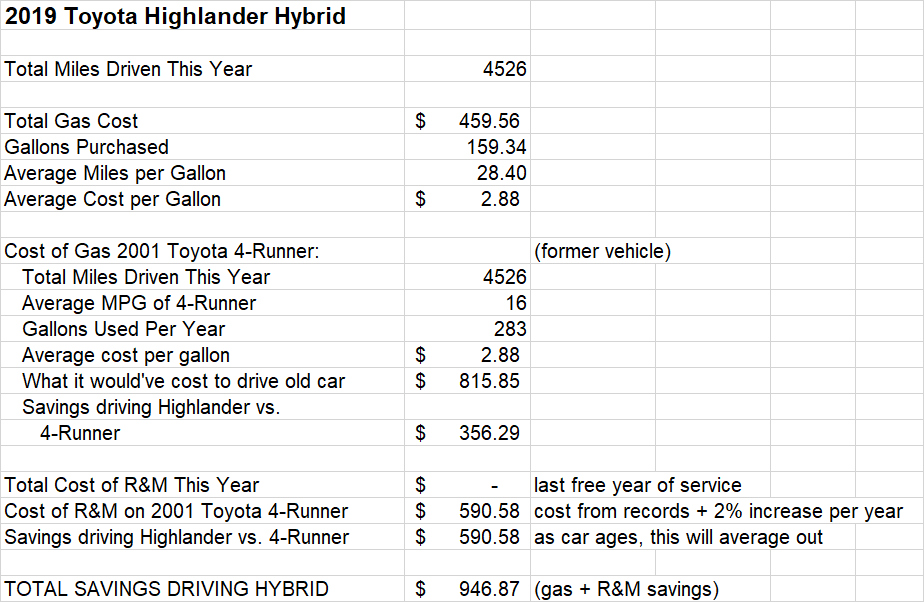
We also still love our Highlander–what a luxurious and smooth ride with lots of fun bells and whistles! We drove 4526 miles during 2020, significantly less than 2019, because we didn’t do long trips and used the LEAF more around Reno. We used only 159 gallons of gas, a savings of 124 gallons and $356 over the 4-Runner for the same mileage, and 3180 pounds of carbon emissions (159 gallons X 20 lbs/gallon). This savings does not take into account the fact that we drove less this year because of the pandemic. So, technically there was even more savings than the formulas above show. I think that was true for most of us. I loved all the data coming out this year that showed how much better our air quality was and how much less carbon we produced worldwide. It gave me hope that we can change our habits and have a healthier planet, which in turn makes us (and everything else living on Earth) healthier too.
The Highlander was still on its 2-year free maintenance contract with Dolan Toyota, so we saved the $590 average, inflation-adjusted cost we used to spend maintaining the 4-Runner. This brings the total savings of driving the Highlander to $947! Hybrids cost about 2/3 as much to maintain as regular ICE vehicles, due to the use electric motors and regenerative braking. We will see how this averages out over time.
This is our all-around vehicle and it continues to do everything we need it to. It is way more comfortable and pleasurable to drive than our old 4-Runner. The combo of the Highlander and the LEAF is perfect for us. We saved $2,273 and nearly 9,000 pounds of carbon from entering our atmosphere. We are thrilled with our decision to replace our old internal combustion engine (ICE) vehicles with the cars of the future!
Stay tuned for updates when we add in our hybrid heat pump systems this year!